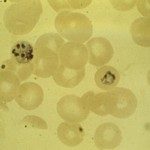Lien vers Pubmed [PMID] – 16397144
Circ Res 2006 Feb; 98(3): 421-8
Congenital heart defects frequently involve a failure of outflow tract (OFT) formation during development. We analyzed the remodeling of the OFT, using the y96-Myf5-nlacZ-16 transgene, which marks a subpopulation of myocardial cells of the pulmonary trunk. Expression analyses of reporter transcript and protein suggest that the myocardial wall of the OFT rotates before and during the formation of the great arteries. Rotational movement was confirmed by Di-I injection experiments with cultured embryos. We subsequently examined the expression of the transgene in mouse models for OFT defects. In hearts with persistent truncus arteriosus (PTA), double outlet right ventricle (DORV), or transposition of the great arteries, rotation of the myocardial wall of the OFT is arrested or fails to initiate. This is observed in Splotch (Pax3) mutants with PTA or DORV and may be a result of defects in neural crest migration, known to affect OFT septation. However, in Pitx2deltac mutant embryos, where cardiac neural crest cells are present in the heart, PTA and DORV are again associated with a rotation defect. This is also seen in Pitx2deltac mutants, which have transposition of the great arteries. Because Pitx2c is involved in left-right signaling, these results suggest that embryonic laterality affects rotation of the myocardial wall during OFT maturation. We propose that failure of normal rotation of OFT myocardium may underlie major forms of congenital heart disease.

